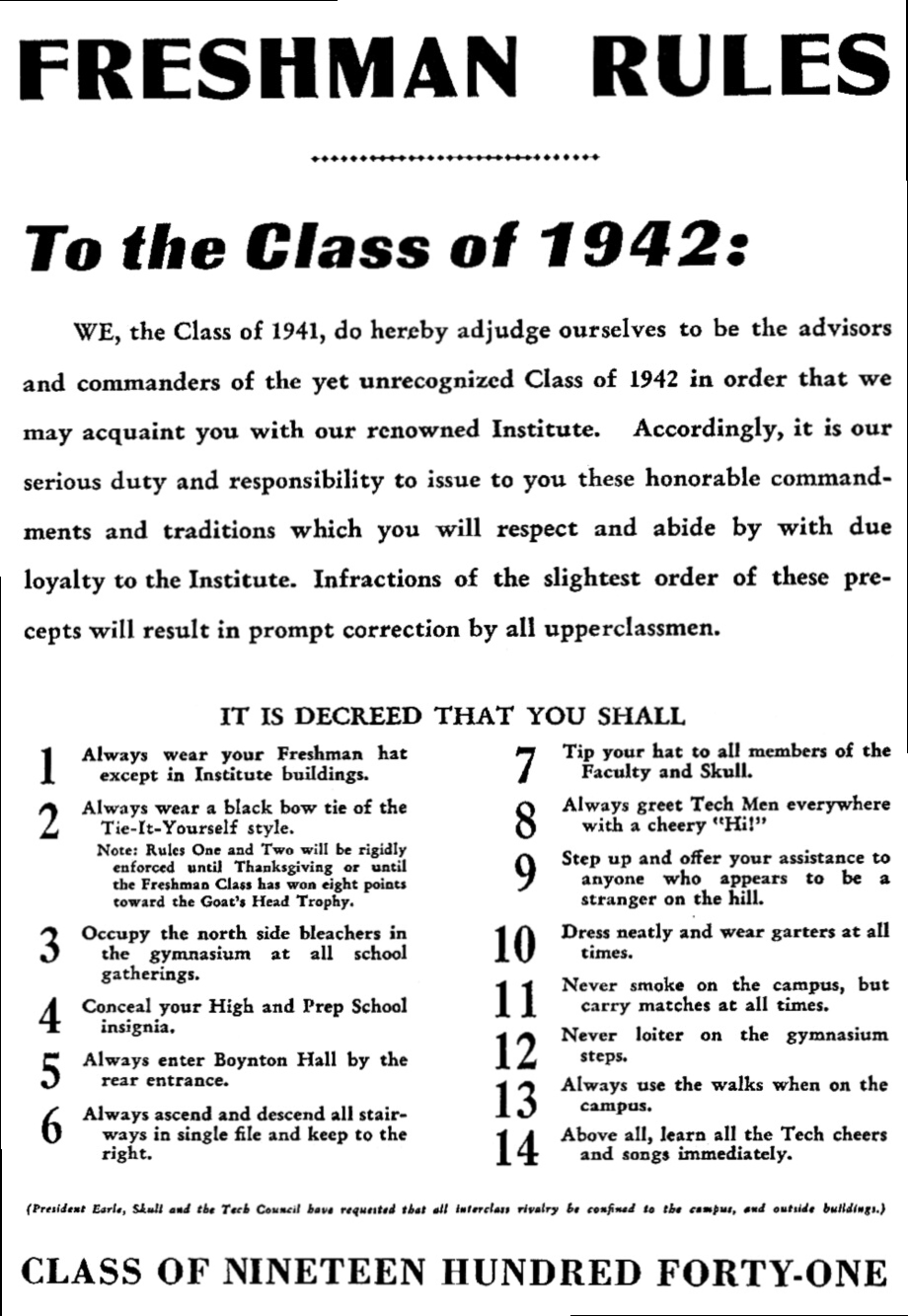WPI Traditions

Traditions are a basis for learning and growth. Traditions help strengthen cultural development in people and are especially vital for younger members of a community. The passing-down of traditions from older to younger generations is essential to the survival of specific aspects of culture. These traditions that repeat year after year can be called customs and beliefs and are present in almost all cultures of the world. Here at WPI, a special emphasis is placed on the customs and traditions that have been passed down since the founding of the Institute.
In almost every aspect of college life at WPI, there is an associated tradition developed from a need to enhance the college experience— competitive spirit, pursuit of knowledge, the strengthening of bonds within groups, and social connection. The customs have changed over time and the ever-changing environment that is our world, but they continue to carry the same sense of pride. The following is a discussion of these evolving traditions and their importance to the WPI campus today.
Early Freshman Traditions
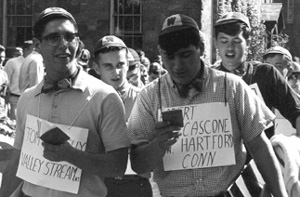
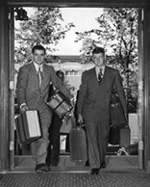
One of the first things an incoming freshman noticed upon his arrival at WPI was that he was different. A freshman was marked as separate from upperclassmen in several ways, and all freshmen participated. After introductions to the school by faculty and administration, freshmen met their nemesis for the next semester: the sophomore class. After this fairly physical first meeting, the rest of the freshmen obligations began.
Beginning in the early 1900s, all freshmen wore beanies. They were maroon and gray with a maroon bill and "W" on the front. If the freshmen were victorious in the Rope Pull, the beanies were allowed to come off. Otherwise, they were worn until Thanksgiving.
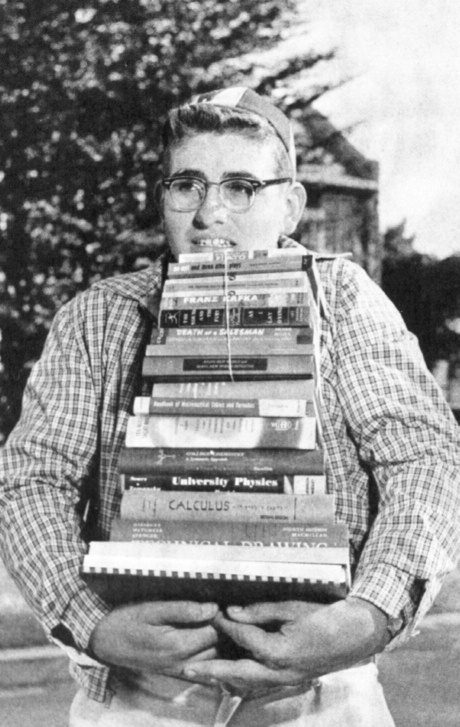
In addition, freshmen were required to wear bow ties during their first week at Tech. Maroon on one side, gray on the other, they were the "real tie" bow ties and were worn so only one color showed.The daily determination of the color was unique. Each morning, freshmen would look at the flagpole that stood where the Quad is today. Whichever flag had been hoisted by the sophomores, maroon or gray, was the tie color of the day. Of course, the flag could be changed during the day and any unlucky freshman caught by a sophomore with the wrong color showing had to re-do his tie.
A freshman tradition that evolved later was the signboard—two 10-inch by 12-inch cardboard placards draped over the shoulders, one in front and one in back. They were marked with lettering precisely two inches high stating the wearer’s name and hometown. This ritual was an excellent way to get to know fellow classmates; it was also invaluable for the fraternities during Rush.
Other Old Traditions
Bridge Crossing: The crossing of Earle Bridge is one of WPI’s oldest and possibly most observed tradition. Traditionally, WPI students were to cross the Earle Bridge as a class only twice in their undergraduate career: Once as freshmen, being welcomed into the WPI community while receiving a Tech Bible and a Freshman Beanie, and once more during commencement, after four years of learning, growing and developing into the cultured, knowledgeable and responsible adults that all WPI graduates become. When West Street was still open to through traffic, freshmen were allowed to cross campus only by using Earl Bridge. Even though all students may cross campus freely, the significance and meaning behind the Earle Bridge Crossing, established many decades ago, is still felt by both incoming freshmen and graduating seniors alike to this very day.
Spree Day: What is now known as QuadFest was originally referred to as Spree Day. One day each spring during the 1960s and 1970s, classes would be de facto canceled. None but a select few would know the exact date of the celebration before the day’s festivities began. Students, along with faculty and staff, would congregate on the Quadrangle and enjoy the new spring. Typically, all those present would consume large quantities of beer that was rolled up to the Quad in trucks. This event fostered social interactions between undergraduates, faculty, and staff. The tradition came to an unfortunate end when the Commonwealth of Massachusetts changed the legal drinking age from 18 to 21.
Tech Carnival: The theme or purpose behind many of the traditions at WPI was the acquisition of the Goat’s Head Trophy. Once the new freshmen had somewhat settled into campus life, the competition for this trophy began.
Tech Carnival was the kickoff event. It originated in 1916 and consisted of three original and unique skits, each about 30 minutes long. The freshman and sophomore classes each performed a skit that they wrote, produced, and cast. While a team of judges was evaluating these two performances, the faculty put on their own skit. This event helped to increase interaction between students and faculty.
For many years, Nils Hagberg, the sole campus policeman at the time, served as the emcee. He would introduce the acts and tell jokes between skits to keep the audience entertained. The carnival was all in good fun and helped the freshmen meet more members of the faculty and the sophomore class. Unfortunately, in the 1960s, many of the skits began to get out of hand—the topics of the skits were thought to be somewhat distasteful. As a result, the faculty no longer felt comfortable participating in Tech Carnival and the event was ultimately retired as a WPI tradition.


Homecoming: Football games and homecomings have long been a part of American college culture and WPI is no exception. At one time, a football rally was held the Friday night before every home football game. The male cheerleaders tumbled and did gymnastics while leading the crowd through the WPI cheers. Bonfires were also held, first in the area that is now the Quad, and later on the baseball field near second base. The bonfires were eventually deemed dangerous to the environment because the material used at the time (railroad ties) polluted the air. Rumor had it that the baseball coach was afraid that nails from the scrap wood being burned would hurt his baseball players sliding into bases. Today, there is still a pep rally, sponsored by the Student Government Association, the night before the big Homecoming game. Directly before the pep rally, the Student Alumni Society passes out rivalry T-shirts to the first 100 freshmen to join in the festivities.
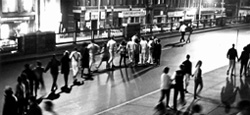
In the early days of the Institute, the Friday evening before Homecoming game festivities culminated in a snake dance from the WPI campus onto Main Street. Some 300 to 600 people would link hands and move through stores, movie theaters, and even public buses, in one unending chain. City officials were notified in advance; nevertheless, traffic would be snarled and the downtown area thrown into confusion. One infamous evening, WPI’s Homecoming coincided with that of Holy Cross. The two groups met at City Hall, where confusion on both sides led to the arrest of 25 people. The snake dance was stopped due to the growing congestion and danger caused by hundreds of people moving through downtown.
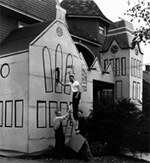
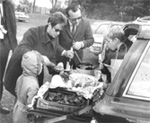
Homecoming festivities once included displays that each fraternity put up in front of its house. Much planning and preparation went into each display, but work was not allowed to begin until the Friday afternoon of Homecoming weekend. Construction continued through the night to ensure completion of the project by Saturday. Many of the displays were animated and followed a general theme of defeating the visiting team. A trophy was awarded to the fraternity with the best display. Today, each fraternity and sorority work on a float to be driven in the Homecoming parade that occurs around noontime on the Saturday of the football game.
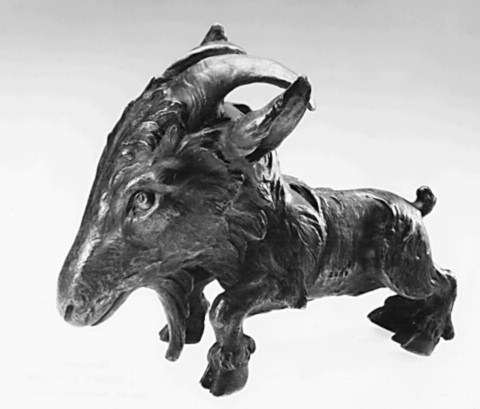
Freshman-Sophomore Rivalry: Also known as the Goat’s Head Rivalry, which dates back to the Class of 1893 whose chosen mascot was a live goat.
A Japanese student, Gompei Kuwada, was given the job of goat keeper because the letters GK corresponded to his initials. The goat remained on the campus for a while, making appearances at several school events. Un fortunately, the task of caring for the goat became quite difficult, so it eventually was "done away with." The goat’s head was then removed, stuffed, and mounted.
Beginning with the Class of 1928, it was decided that more school spirit would result if the head were made the object of a class rivalry. A bronze statue of the goat was created—with a life-size head and a disproportionately small body—and became known as the Goat’s Head Trophy. The competition was organized around a point system and focused on the two youngest classes; points were awarded to the winners of various events such as sports (football, basketball, track), Tech Carnival, Paddle Rush, and the Rope Pull. At the end of the year the class with the most points would be awarded the Goat’s Head Trophy.
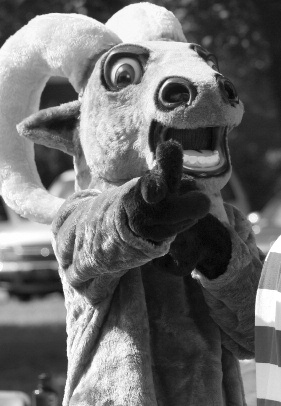
|
Gompei the Goat embodies all that is treasured in WPI’s deeply rooted traditions. Full of school spirit, Gompei makes frequent appearances at events that bring the entire school together as a community appearance is greeted warmly by all. Watch for him at sports events (basketball games) and alumni-related events (Homecoming, Reunion Weekend). |
Whichever class had possession of the Goat’s Head was required to display it once a year. This gave the other classes the opportunity to steal it for themselves. Many classes came up with innovative ways to display the Goat’s Head—including hanging it from a helicopter during a home football game, dropping it from Earle Bridge into a moving convertible, roller blading past participants in the annual Traditions Day Candle Walk, and hanging it in Alumni Gym during a basketball game, where it was then swung out a window to those waiting outside.
The rivalry faded out in the 1930s, then was brought back for several years in the 1950s and 1960s. However, the administration thought the rivalry posed a threat to the students, so it was discontinued. It wasn’t until 1995 that it was revived and another replica of the Goat’s Head was created (the original has been preserved for safekeeping).
As in the past, the two youngest classes compete in a series of events throughout the year, earning points for those they win. The events included in the current rivalry are the Rope Pull, Eskimo Relays, Celebrity Squares, Traditions Day events, and the Junior/Senior Mystery Event at Quadfest. Each event counts equally toward the rivalry and at the end of the year the class with the most points is awarded the trophy. Another way of getting the trophy is by stealing it from the class who currently has it. If one class fairly steals the trophy from the other class, it is eligible to have its year engraved on the Goat’s Head Trophy.
Freshman-Sophomore Rivalry Rules
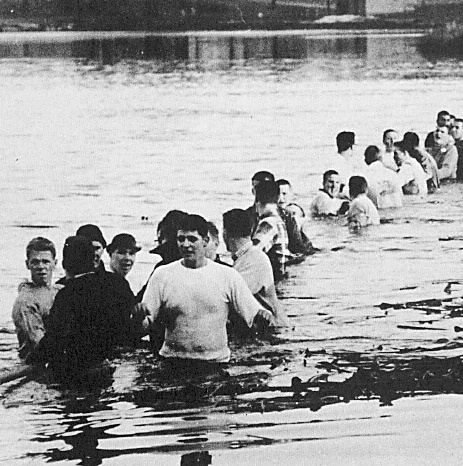
Rope Pull: Each year the first event in the quest for the Goat’s Head Trophy is the Rope Pull. The original tug-of-war was held at Salisbury Pond in 1909. Each team was composed of 40 members whose respective sides of the pond were designated by the flip of a coin. The opposing teams lined up on opposite sides of the pond and began the battle, with the objective of pulling the other team into the pond.
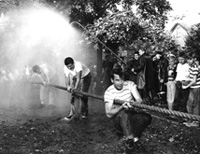
The popularity of this event grew and each class developed a modified set of rules. In 1927, the Tech Council limited the Rope Pull to 30 minutes so that the participants and spectators could attend the Homecoming football game earlier in the afternoon (on occasion, these battles had been known to last as long as two hours!). Another rule that emerged required the youngest sophomore brother of Phi Gamma Delta fraternity to dress in a tuxedo and be first in line on the sophomore side. In 1954, Institute Pond (formerly Salisbury Pond) was completely drained, which created a problem for the competition. The event was moved to the parking lot between Kaven Hall and Skull Tomb. Rather than being dragged into the pond, the loser was pulled through the spray of a fire hose. Today, a fire truck is still used to hose down the losing class, even though the Rope Pull is again held at Institute Park.
Celebrity Squares: The second event of the Goat’s Head Rivalry is played like the television show Hollywood Squares. It is held each November during the celebration of Founders Day. A panel of alumni, faculty, and students, portraying notable WPI figures from past and present, make up the panel. The students are split up into two teams, sophomores and freshmen, and must either agree or disagree with the panel’s answers to various questions about the history and traditions of WPI. Students participate in several rounds of play, and the class with the most correct answers at the end wins and is one step closer to obtaining the Goat’s Head Trophy.
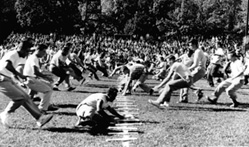
Eskimo Relay: The third event of the Rivalry is held during Winter Carnival. It takes place on the Quad and, depending on the weather, usually involves snow. The goal of this event is to be the team who completes the relay, involving various pieces of WPI paraphernalia, in the least amount of time.
Pennant Rush: This is the first of three rivalry events held on Traditions Day. Throughout the years, the Pennant Rush has been modified several times. In 1907 and 1908, canes were used rather than pennants, but paddles eventually replaced them due to the death of a student who was participating in the event. The Paddle Rush became an annual event that occurred during halftime of the first home football game of the school year. One hundred paddles were placed on the 50 yard line as the two classes, each composed of no more than 100 members, would prepare for the rush starting from opposite sides of the field. On a given mark, the two teams would charge toward the paddles to see who could acquire the greatest number in 10 minutes.
The acquisition of paddles was not only a challenge, but a painful experience. Over the years, controversy concerning the brutality of the Paddle Rush increased. In 1924, this competition was changed to a Flag Rush. It was still a freshman-sophomore competition, but involved the use of a flagpole and a flag instead of the paddles. The sophomores would raise their flag, grease the flagpole, and stand in a close-knit circle while the freshmen tried to devise a way to break through and capture the flag. President Earle abolished the Flag Rush after two years.
Today this event is known as the Pennant Rush, and is run in the same fashion as the Paddle Rush. Each student may carry only one pennant back to his or her end of the field on each trip. Wrestling a pennant from another person is permitted, and the class that collects the most pennants is declared the winner.
Cage Ball: The second event of Traditions Day is held on the football field. Freshmen and sophomores begin at the end zone on opposite sides of the giant cage ball, each class attempting to gain control. The students push against the cage ball with the objective of getting it to the other team’s end zone. Whichever team gets the ball to the opposite side wins.
Jeopardy: The third Traditions Day event is similar to the television show Jeopardy, complete with buzzers and a computer-generated game board. Questions focus on the history and traditions of WPI and the class with the most points at the end of "Final Jeopardy" wins.
Junior/Senior Mystery Event: Held during Quadfest in the spring, this is the final event in the Goat’s Head Rivalry. As its name suggests, the junior and senior members of the Student Alumni Society plan this event and it is a surprise to the freshmen and sophomores.
New Student Orientation: NSO is a five-day program to introduce students to campus life at WPI. Members of the fraternities and sororities assist the new students and their families in moving their belongings into the residence halls. Orientation Leaders (now called Community Advisors) work with the freshmen on a weeklong project and lead fun activities that immerse new students in life at WPI. At the conclusion of NSO, the freshmen enter into a two-term peer advising program known as Insight, which is led by their Community Advisor, a resident advisor, and a faculty advisor.
Founders Day: Each year on November 11 (the anniversary of Boynton Hall’s dedication in 1868), one of WPI’s nine founders is honored. Student volunteers participate in reenactments of the school’s history and share readings in classrooms on the founder celebrated that year. Faculty, staff, and alumni provide artifacts for display, and a live goat is present on campus. Celebrity Squares (the second Goat’s Head Rivalry event) is held in the evening.
Winter Carnival: Coordinated by the Social Committee (SocComm), this event is held to distract students from schoolwork and their yearning for winter break. It provides a well-deserved break in the academic life of WPI students just before finals. Activities include a Klondike-bar hunt, various rides, and several events and programs sponsored by different student organizations throughout the week. The third of the Freshman-Sophomore Rivalry events (Eskimo Relay) is held during Winter Carnival. The Major and Special Events Committee (MSEC) of SocComm also hosts a large concert or comedian performance during the week.
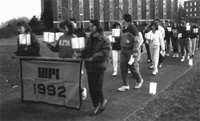
Traditions Day: This community event was first held on April 16, 1991. Its primary objective was to educate faculty, staff, and students about the history and traditions of WPI. The students enjoyed such activities as a Pie Eating Contest and a Dunk Tank (to dunk their "favorite" faculty or staff member). Higgins House was temporarily transformed into a museum with original drawings and artifacts. The grand finale of the day’s events, which were sponsored by the Student Alumni Society, was a campus-wide candle lighting ceremony that began on the Quad and ended in Institute Park.
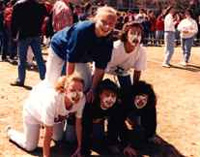
Traditions Day is now held on the second Thursday of April. It’s a time to reflect on WPI’s history and traditions. On the evening before, a Candlewalk around campus is done while singing the Alma Mater. On this day, SAS members host three Freshman-Sophomore Rivalry events: Pennant Rush, Cage Ball, and WPI Jeopardy. The class to win two out of three events wins the rivalry point for the day.
During the intermission of Jeopardy, there is an Alma Mater contest, in which various groups on campus enter and present original renditions of the WPI Alma Mater. The contest is open to all groups who want to be creative with the Alma Mater and put on a good show for the students and judges.
Quadfest: Perhaps the biggest student celebration on campus during the school year, Quadfest marks the completion of the academic year for most students. It is coordinated by SocComm and events are sponsored by several student organizations. Throughout the week, several bands, novelties, and activities are available to help students take their minds off finals. The Junior/Senior Mystery Event (the final event for the Goat’s Head Rivalry) is held during Quadfest.
Gompei’s Birthday: A time for WPI students to celebrate with their favorite goat. It is hosted by the Student Alumni Society, and features inflatables, party games, and of course, birthday cake. Gompei makes an appearance and poses for photographs. Another attraction is “Pie WPI” in which students can pay for the chance to throw a pie at a faculty member or student. All proceeds are donated to a charity selected by the Student Alumni Society.
Maintained by webmaster@wpi.edu
